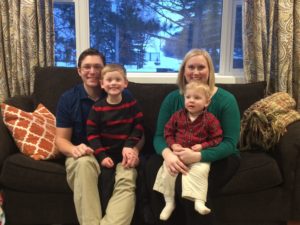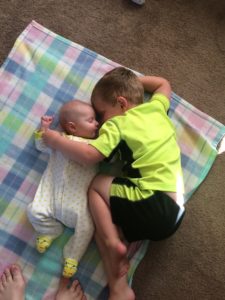by Dennis Dalman
editor@thenewsleaders.com
Most people, if they even hear of it, will dismiss from their minds National Kawasaki Disease Awareness Day, Jan. 26. Most have never heard of it.
Not the Stephen and Julie Muenchow family of Sartell. They hope people on that day and forever after will learn and remember what that disease is. Kawasaki can be deadly if it is not caught in time.
And they should know. Their baby, Gavin, had it when he was born May 5, 2016, but his parents didn’t know it, their doctors didn’t know it and nobody else had a clue. At least not at first. Gavin had symptoms that were puzzling but not necessarily alarming. He had a persistent fever, then he had what seemed like “pink eye” followed by a body rash and a swollen and reddish tongue.
The symptoms began appearing 12 days after Gavin was born. Eventually, medical experts put two and two together, they connected the dots and then they knew the baby’s symptoms spelled Kawasaki disease, named for the Japanese doctor who first described it in 1967.
It is also known as mucocutaneous lymph-node syndrome. What happens is blood vessels throughout the body become inflamed, causing heart problems that can prove fatal to children unless the disease is treated in time.
The inflammation of blood vessels can weaken and destroy the heart, killing a child. It can be remarkably rapid if the disease is not recognized and treated in time. And time is the crucial word. If not treated in a very narrow window of opportunity, the disease almost certainly will be fatal. The cause of Kawasaki disease is, so far, unknown, although experts suspect a combination of genetic and environmental factors, perhaps complicated by auto-immune mechanisms that can trigger it. Airborne pathogens have also been suspected.
No clue
The Muenchow family had never heard of Kawasaki disease. When Gavin, their second boy, was born, they suspected nothing other than why his persistent fever just would not go away.
“His fever lasted day in, day out,” Julie Muenchow said. “It was so bad he finally had to go to Children’s Hospital (in the Twin Cities). Then there was his swollen red tongue, body rash, red eyes, inflammation.”
Fortunately, adding up the strange symptoms, doctors figured it out: Kawasaki disease.
Before the diagnosis, Julie and Stephen endured a roller-coaster ride of awful emotions.
“It was terrifying,” Julie. said “The worst part was the not-knowing. Not knowing what was wrong. And no plan of action. All that was going on was treating symptoms after he was 6 weeks old.”
Kawasaki disease most often afflicts children ages 5 and under, with children between the ages of 2 and 4 being most common. It is most prevalent in Asian boys, but it can afflict girls, too, and children of any race.
Cure
Fortunately, an intravenous treatment saved Gavin’s life. An injection of immunoglobulin (a product of blood plasma) worked wonders for Gavin after only one infusion.
“In just 12 hours after the infusion, there was a big improvement in Gavin,” Julie said. “It was amazing. It was the final piece of the puzzle. We were told the intravenous treatment shocks the immune system from going into overdrive.”
The Muenchows, however, didn’t dwell on the medico-techno specifics. They were just so happy to have Gavin back, smiling, happy, healthy. And so was Gavin’s older brother, 5-year-old Owen. Young as he was, he was so worried about his younger brother, whom he called “My Baby.”
Owen instantly noticed how Gavin had come back healthier, happier.
“Gavin is so happy-go-lucky now,” Julie said. “He’s ever so sweet. So healthy.”
A year after his diagnosis his heart looks just fine.
Be vigilant
The Muenchows are grateful for Kawasaki National Awareness Day, Jan. 26, because they want all parents to learn the symptoms of the disease: persistent fever, reddish eyes, swollen bright red tongue and body rashes.
The Muenchows are also firm believers in blood donation. It takes about 1,000 individual blood donations to provide the plasma from which the immunoglobulin cells are derived and used for infusions that cure Kawasaki disease.
“Be persistent and trust your instincts,” Julie advised other parents. “What may seem very insignificant, like a rash, can be a very important clue. It’s important to write down symptoms when they happen so they can be put together like pieces in a puzzle if need be later.”
To learn more about Kawasaki disease, google Kawasaki Kids Foundation and/or Kawasaki Disease Foundation.

The Muenchow brothers (Gavin left, Owen right) are inseparable buddies, especially after Gavin’s life was severely threatened by a mysterious disease.

The Meunchow family of Sartell has discovered a radiantly happy new lease on life now that baby Gavin has been cured of a terrible maladay known as Kawasaki disease. From left to right are father Stephen, son Owen, mother Julie and Gavin.

Owen Muenchow (right) gives a kiss and a hug to brother Gavin shortly after Gavin’s health was restored.



